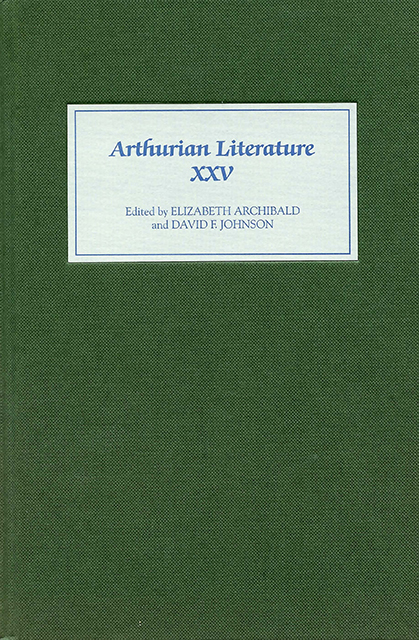Book contents
- Frontmatter
- Contents
- Illustrations
- Foreword
- Contributors
- Abbreviations
- I Geoffrey of Monmouth and the Merlin Legend
- II The Enchantress, The Knight and the Cleric: Authorial Surrogates in Arthurian Romance
- III ‘Morgan Le Fay, Empress of the Wilderness’: A Newly Recovered Arthurian Text in London, Bl Royal 12.C.IX
- IV Malory's Lancelot and the Key to Salvation
- V Chrétien in Ivory
- VI ‘An Empire of Itself’: Arthur as Icon of an English Empire, 1509–1547
I - Geoffrey of Monmouth and the Merlin Legend
Published online by Cambridge University Press: 10 March 2023
- Frontmatter
- Contents
- Illustrations
- Foreword
- Contributors
- Abbreviations
- I Geoffrey of Monmouth and the Merlin Legend
- II The Enchantress, The Knight and the Cleric: Authorial Surrogates in Arthurian Romance
- III ‘Morgan Le Fay, Empress of the Wilderness’: A Newly Recovered Arthurian Text in London, Bl Royal 12.C.IX
- IV Malory's Lancelot and the Key to Salvation
- V Chrétien in Ivory
- VI ‘An Empire of Itself’: Arthur as Icon of an English Empire, 1509–1547
Summary
In a recent study Oliver Padel subjected the origins of the Merlin/Myrddin legend to a careful re-examination. A. O. H. Jarman contended that the name and prophetic character of Myrddin arose from nothing more than ætiological speculation on the placename Caerfyrddin (Carmarthen), which in reality derives from British *Moridūnon (‘sea-town’). This shadowy figure subsequently acquired features of the legend of a North British wild man named Lailoken. Geoffrey of Monmouth absorbed this composite legend into his Historia Regum Britannie, to which he adapted Nennius's account of the fatherless child Ambrosius. He further placed a lengthy prophecy in the mouth of his Merlin, loosely based on Welsh prophecies ascribed to Myrddin. This Merlin's floruit Geoffrey located in the reign of Vortigern, which his chronology makes plain lay in the middle of the fifth century AD.
A decade or so later Geoffrey composed his lengthy poem Vita Merlini, which contained much new material about its hero. While Merlin remains a prophet (vatis), in virtually every other respect his story is radically altered. He is described as ‘king and prophet of the men of Dyfed’ (‘Rex erat et vates Demetarumque’), which does not correspond to anything in the Historia. While the Historia represents Merlin as born in Dyfed and uttering his prophecy in Gwynedd, all events in the Vita Merlini take place in North Britain. A terrible battle is fought between Peredurus king of Gwynedd and Guennolous king of Scotia. Merlin accompanies Peredurus, who is allied with Rodarcus king of the Cumbrians. Driven mad with horror by the bloody conflict, Merlin takes refuge in the forest of Calidon. King Rodarcus, who is married to Merlin's sister Ganieda,presses the seer to come and live in comfort at his court, but the wild man finds himself unable to endure the constraints of civilization and flees back to the forest. After various adventures he settles there, where he is joined by another seer named Telgesinus and his sister Ganieda. They engage in learned discussions, ranging from encyclopædic lore familiar to scholars of Geoffrey's era to vaticinations alluding to events contemporary with his composition.
The battle is implicitly identified in a Scottish source with Arderydd, a site near Carlisle, which according to the Annales Cambriæ was fought in AD 573.
- Type
- Chapter
- Information
- Arthurian Literature XXV , pp. 1 - 42Publisher: Boydell & BrewerPrint publication year: 2008



